Camilla Wicks, Jean Sibelius, Sixten Ehrling, Stockholm Radio Symphony Orchestra - Sibelius The Swan Of Tuonela The Return Of Lemminkainen Concerto in D minor
Album: Sibelius The Swan Of Tuonela The Return Of Lemminkainen Concerto in D minor
Rating: 3.0
Download
Filename: camilla-wicks-jean-sibelius-sixten-ehrling-stockholm-radio.zip- MP3 size: 23.5 mb
- FLAC size: 274.5 mb
Table of Contents
Tracks
| Track | Duration | Preview |
|---|---|---|
| Third Movement - Allegro Ma Non Tanto | ||
| The Return Of Lemminkainen | ||
| First Movevement - Allegro Moderato | ||
| The Swan Of Tuonela | ||
| Second Movement - Adagio Di Molto |
Images
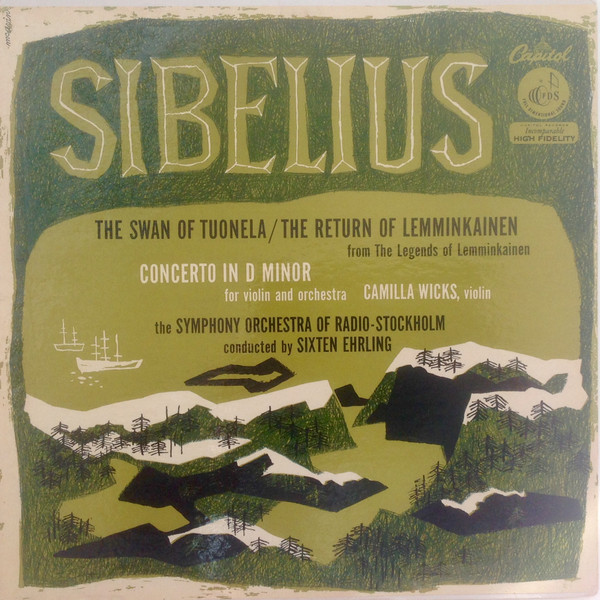
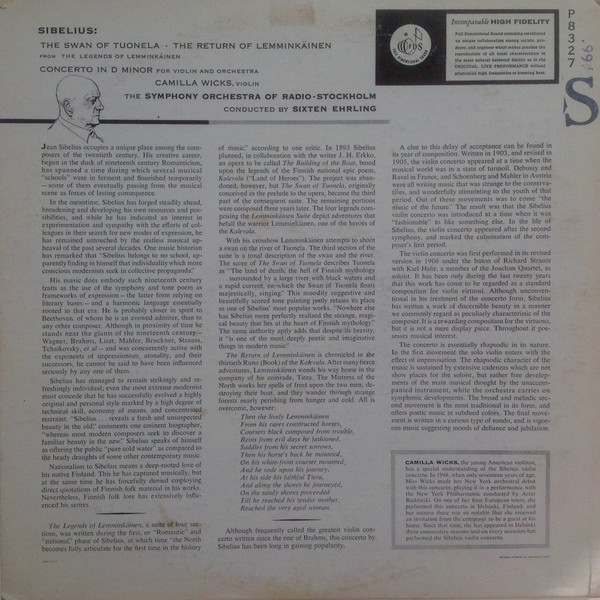
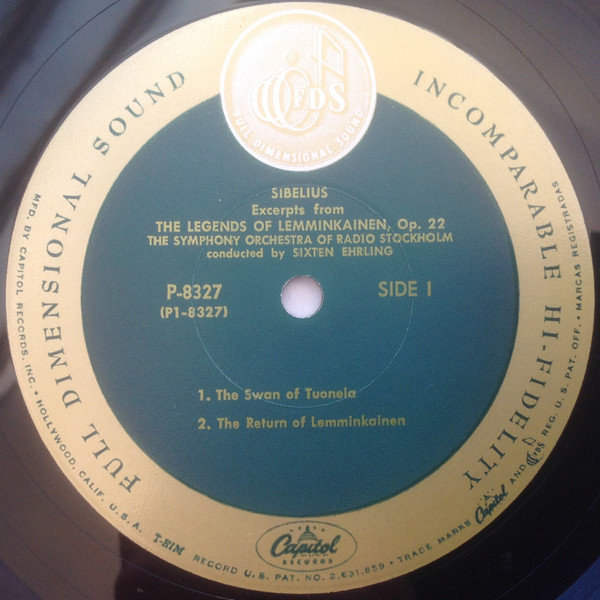
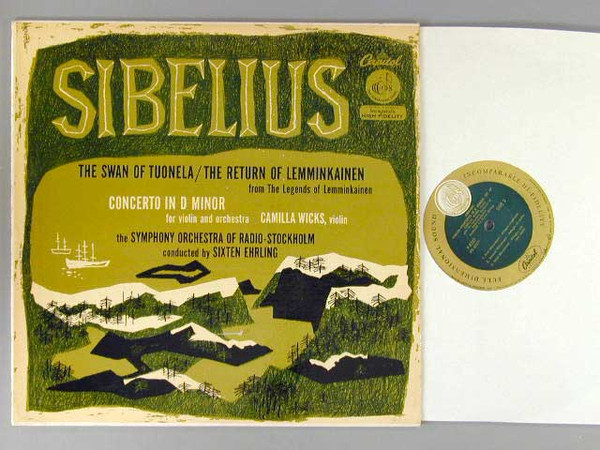
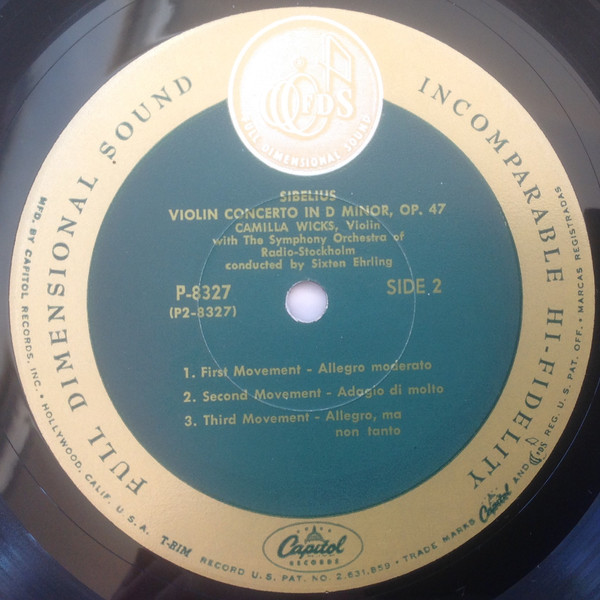
Catalog Numbers
P8327Labels
Capitol RecordsListen online
- lytte på nettet
- kuunnella verkossa
- online anhören
- ouvir online
- online luisteren
- lyssna på nätet
- escuchar en línea
- écouter en ligne
- ascolta in linea
Formats
- Vinyl
- LP
- Mono
Companies
| Role | Company |
|---|---|
| Pressed By | Capitol Records Pressing Plant, Scranton |
Credits
| Role | Credit |
|---|---|
| Composed By | Jean Sibelius |
Notes
Mono only. Laminated front cover, QFDSBarcodes
- Matrix / Runout (Stamped runout side 1): P1-8327-D2 [Capitol Scranton "anvil" stamp]
- Matrix / Runout (Stamped runout side 2): P2-8327-D3 [Capitol Scranton "anvil" stamp]
About Camilla Wicks, Jean Sibelius, Sixten Ehrling, Stockholm Radio Symphony Orchestra
American-Norwegian violinist, born in 1928. Died November 25, 2020 in Weston, Florida.
Born in Long Beach, California, on August 9, 1928, Camilla Wicks led a stellar career in the dozen years after World War Two, one of a select group whose achievements helped to establish women violinists' prominence on the concert stage. It is worth considering that around that golden time, the likes of Heifetz, Milstein, Menuhin, Francescatti reigned supreme; the veterans Szigeti, Elman and Thibaud were still active and beloved; Stern was a firm favorite, Rabin a prodigious sensation, and Oistrakh and Kogan were just resoundingly breaking through the Iron Curtain. In this illustrious company, Wicks was considered one of the great soloists on both sides of the Atlantic, upheld by many as a queen among violinists. At the peak of her fame and subsequently, she retired more than once to devote herself to her family, but remained an outstanding if intermittent performer for many more decades. While her vinyl records have long been revered by collectors, this CD release of early live performances offers a vital opportunity for a more widespread audience to discover this astonishing artist.
Camilla Wicks on the Sibelius Concerto and Sixten Ehrling:
I first performed the Sibelius Concerto when I was fifteen, at the Leventritt Competition, where I was given second prize. Francescatti heard me there and was instrumental in arranging for me to perform it with the New York Philharmonic, for my Carnegie Hall debut. I then played it many times in Scandinavia, in Finland. On one occasion, Sibelius heard a broadcast performance of mine on the radio and invited me to meet him at his villa. When I asked him to comment on my interpretation, he said:
Just play it the same way.
Although the language barrier meant communication was limited, it was still an inspiring experience.
To make the recording with Ehrling , I arrived in Stockholm in the midst of a strenuous tour playing every night and travelling every day. I recall that the night before I had attended a post-concert reception, in Göteborg or Malmö, after which I had to use a back bedroom to practise the Sibelius, which I hadnt been able to practise for 2 weeks. I caught a sleeper train still in my concert dress. The next morning I had to be early at the Stockholm Royal Academy of Music, where the recording took place, and I had little time to warm up. With just the one session for the recording and no splicing to be done then, there was great tension particularly to get the last movement done. By that point I was exhausted and right at the end I did something wrong, so we had to do it all over&Afterwards we listened to see if anything was too bad we didnt have time to do much in those days. With the passing of time, I have changed my approach to certain passages. For instance, the complicated rhythms of the double-stops in the slow movement can be played exactly as written, but I played them more freely then.
Ehrling and I had toured together, including recitals, so it was a matter of friends making this recording. He was a wonderful pianist indeed, I heard him perform spectacularly as soloist. There was a real chemistry between us, and he was such a marvellous musician, always understanding, innately and intuitively musical. He had a wonderful sense of tempi, and of where and how to place a ritardando. I played many concertos with him and every time I was thinking:
Yes! This is the way it must be&
He once totally surprised and overwhelmed me with an acceleration in the middle of the Brahms Concertos slow movement that was much more pronounced than usual and just marvellous. It worked in a way that a soloist can never accomplish alone, no matter what the pre-rehearsal talks and plans. Its something coming from the core of the conductors vision straight into the soloists like a meeting of souls. I can still feel it today.
Real Name
- Camilla Dolores Wicks
Related albums
Top Albums
Funckarma - Parts
The Jam - Greatest Hits

John Ridout & Ross Self - Closer
Devon Russel - Next To You
Various - La Foresta Della Morte The Deadly Forest
Various - Anacreonticks The Golden Age Of Song Authentic English Music And Drinking Songs For Clubs Societies Wine Cellars Licensed Taverns Music Halls And Pleasure Gardens
Klaus Badelt And Ramin Djawadi - Beat The Drum Original Motion Picture Soundtrack

Georgette Fry & The BSide Blues Band - Let Me Drive
Choking Victim - Advanced Promo Cassette
Various - The Best 70s Megamix
Various - The Essential Blues
Bloodnote, Megalodon , Mourning Souls - Experimental Noise Grind Split
